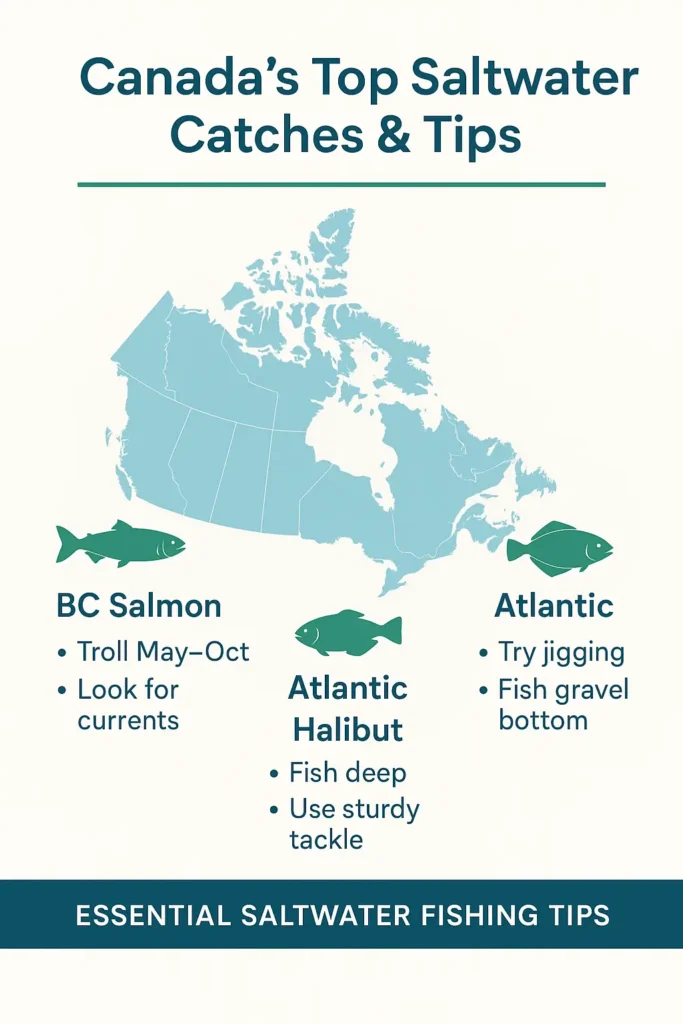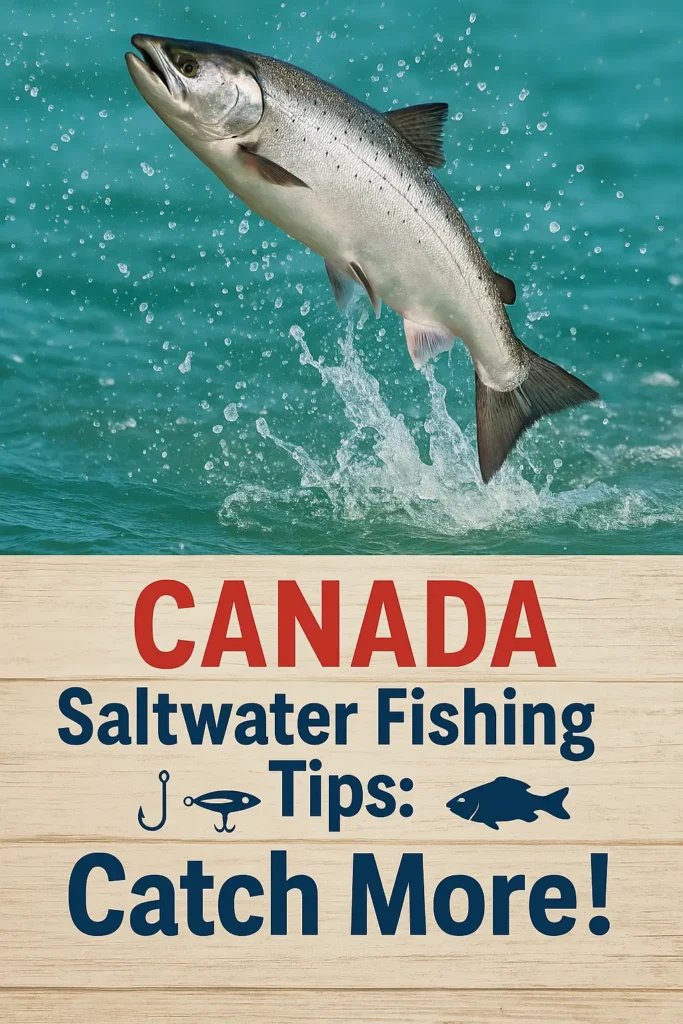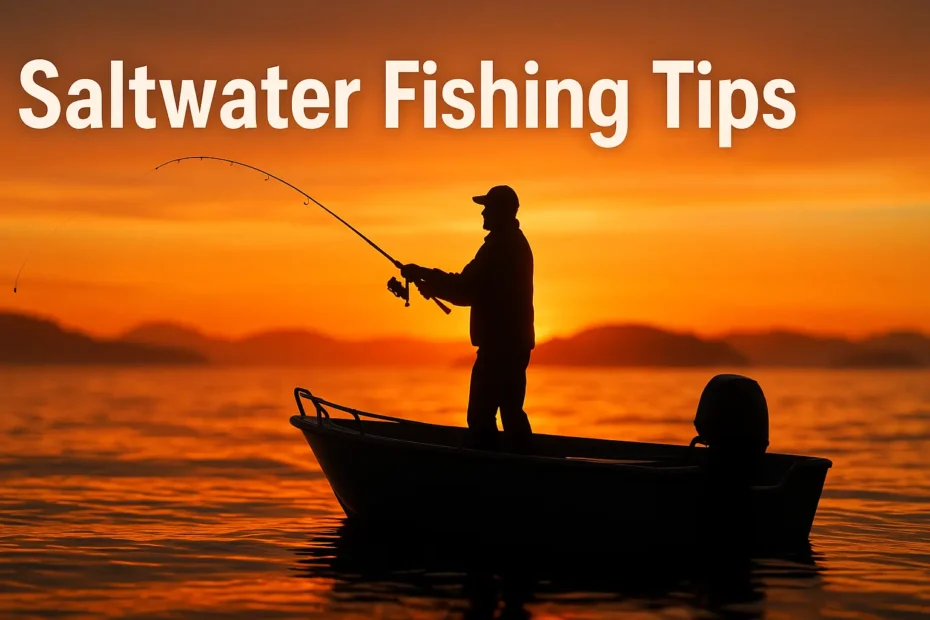Good saltwater fishing means knowing your fish and using the right gear. These saltwater fishing tips help you catch more in Canadian waters.
In a Nutshell: Saltwater Fishing Tips
- You will learn key saltwater fishing tips for Canada.
- You will find out about the best fish, seasons, and spots.
- You will get simple ideas for good gear and smart ways to fish.
- You will understand how to fish safely and protect the waters.
Do you love the big ocean and the thrill of a catch? Saltwater fishing in Canada is a great adventure. Knowing a few good saltwater fishing tips can make your fishing trips much better and more fun.
Estimated reading time: 6 minutes
Know Your Fish and Best Times
Canada has two big coasts for saltwater fishing: the Pacific and the Atlantic. Many kinds of fish live there.

Popular Fish in Canada:
- Pacific Coast (British Columbia): You can find Salmon (like Chinook and Coho), Halibut, and Lingcod.
- Atlantic Coast (East Canada): Look for Atlantic Salmon, Cod, Mackerel, and Tuna.
Knowing the fish helps you choose the best saltwater fishing tips.
Best Seasons for Salmon (A Key Target):
Different salmon types are active at different times.
- Atlantic Salmon: Best from May to September. Many areas ask you to catch and let go.
- Chinook Salmon: Good all year, but best from May to October.
- Coho Salmon: Look for them from June to October.
- Sockeye Salmon: Active from July to September.
- Pink Salmon: Mainly August to October, often in odd-numbered years in BC.
Timing is very important. Using the right plan for the fish you want is key. Good timing and plans are vital for Canadian fishing.
- Check Tides: Fish often feed more when the tide is moving. Look up local tide charts before you go.
- Match Bait: Try to use lures or bait that look like what fish eat in that area. Watch for small fish or crabs.
- Stay Sharp: Keep your hooks sharp. A sharp hook sets better in a fish’s mouth and you will lose fewer fish.
Smart Saltwater Fishing Tips: Gear and Ways
Using the right tools and methods will help you catch more fish. These saltwater fishing tips cover what you need.

Good Ways to Fish
- Trolling: Pulling a lure behind a moving boat. Great for Salmon and Tuna. Use lures that look like small fish.
- Mooching: A classic way in BC for Salmon. You drift bait to look like a hurt fish.
- Fly Fishing: Good in shallow water for Salmon and Trout. You need special flies.
- Jigging and Casting: Good for fish near the bottom, like Lingcod. Use metal jigs or soft plastic baits.
What Gear to Use
- Rods and Reels: Get medium to heavy saltwater rods. Reels should not rust easily.
- Line: Braided line (20-30 lb test) is strong. Use a fluorocarbon leader (a short piece of clear line at the end) so fish don’t see it.
- Hooks: Use barbless hooks (no spike on the back). This is often a rule in Canada to help fish survive if you release them, as noted by Fisheries and Oceans Canada.
- Other Tackle: Use swivels to stop line twists. Pick good lures for your target fish.
Read the Water and Weather
- Tides: Fish often feed when the tide moves in or out. Check tide times.
- Water Temperature: Fish care about how warm the water is.
- Weather: Cloudy, windy days can make fish bite more. Big weather changes can affect fish.
Simple Lure Chooser
Top Canadian Spots and Fishing Smart
Canada has amazing places for saltwater fishing. Always remember to fish smart and safe.
Great Fishing Spots
- British Columbia: Famous for Salmon and Halibut.
- Newfoundland & Labrador: Lots of Atlantic Salmon, Cod, and Tuna.
- St. Lawrence River: Good for migrating Salmon.
- Bay of Fundy: Known for big tides and fish like Striped Bass.
- Vancouver Island: Popular for Halibut and Salmon.
- Halifax, Nova Scotia: Good spots in protected bays.
You can find more details on these top spots for your next trip.
Pro Saltwater Fishing Tips for 2025
Expert fishers suggest these ideas:
- Try different lure colors and sizes. Match what local baitfish look like.
- New tools like forward-facing sonars can help find fish. These show you fish under the water.
- Practice casting well. How you reel in your line matters.
- Be quiet near fishing spots. Loud noises can scare fish.
- Some YouTube videos share proven tips like changing your methods based on the season and watching fish closely.
Keep it Safe and Clean
- Safety First: Always wear a life jacket. Tell someone where you are going. Weather can change fast.
- Protect Nature: Take all your trash with you. Do not leave fishing line behind.
- Respect Rules:
- Use barbless hooks.
- Respect areas where you must release fish.
- Follow fishing season dates.
- If you see illegal fishing, you can report it. Call 1-833-DFO-TIPS (336-8477).
- Always check if you need a fishing license for the ocean.
Conclusion
With these saltwater fishing tips, you are more ready for Canada’s oceans. Plan your trip, fish safely, and have fun. We hope you enjoy your time fishing in Canada!
Your Questions About Saltwater Fishing Tips Answered (Simply)
What is the best bait for saltwater fishing?
What is the best time of day for saltwater fishing?
What basic gear do I need for saltwater fishing?
How do tides affect saltwater fishing?
Can you saltwater fish from shore in Canada?
What is an easy saltwater fish to catch for beginners?
Do I need a license for saltwater fishing in Canada?



